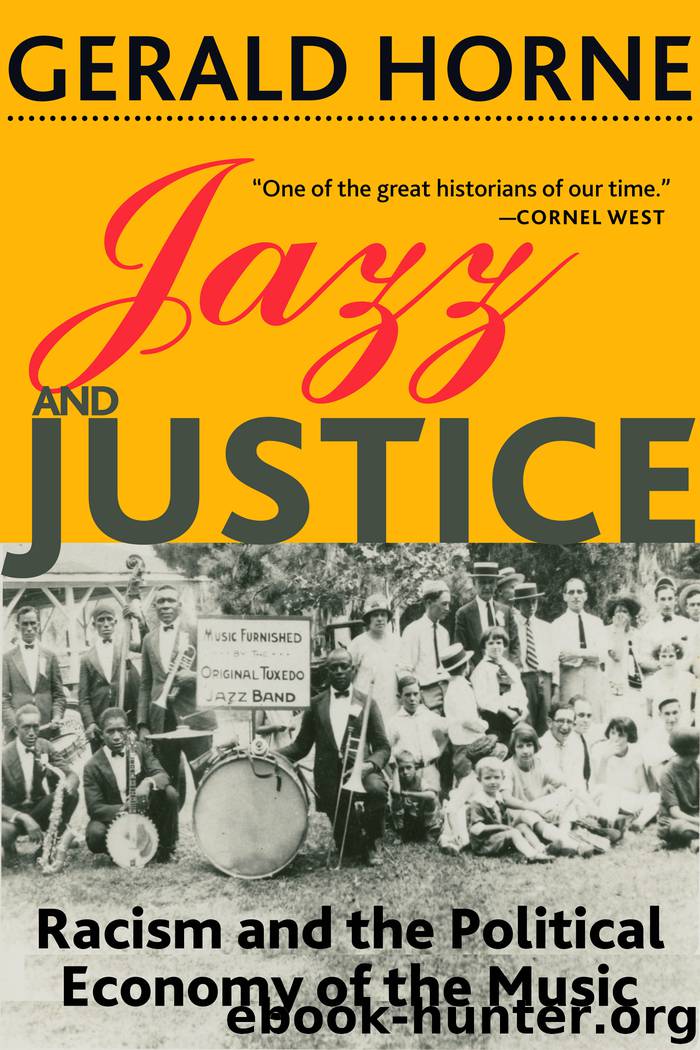Jazz and Justice by Gerald Horne;

Author:Gerald Horne;
Language: eng
Format: epub
Publisher: New York University Press
Published: 2019-06-21T16:00:00+00:00
9. I Wish I Knew How It Would Feel To Be Free
THE 1960s, ACCORDING TO ONE ANALYST, was “one of the worst periods for jazz in its history.” Actually, this premature burial of the music became a staple with the rise of television’s popularity, the “British invasion,” and the companion “invention” of a new form—rock ’n’ roll—which some saw as a whitewashed offshoot (in the manner of “West Coast Jazz”) of what had been colorfully called rhythm ’n’ blues. It was true, however, that what was demurely termed “racial strife” erupted periodically, as had been the case since Little Rock in 1957 and Oxford, Mississippi, in 1962,1 then a turnabout of sorts with Los Angeles in 1965.2 The federal government enacted civil rights legislation in 1964, followed by the Voting Rights Act of 1965, which, ideally, should have broken the back of Jim Crow, but this system of iniquity was too deeply embedded to disappear readily and touring bands often still faced rough injustice, particularly when passing through Dixie.
Likewise, the music’s sponsor-cum-exploiter—Organized Crime—was hardly squelched as a progressive anti–Jim Crow movement arose, complemented nicely by vibrant feminist and antiwar movements. By 1960, the Nevada authorities—with oversight over Las Vegas, a rival of New York and nearby Los Angeles as an employer of musicians—were engaged in a typical exercise: vetting an employer’s credentials that were soaked with illicit ties. In 1960, the target was the curiously named “Nig Rosen … closely associated with Meyer Lansky,” the reputed brains behind the entity popularly denoted as “La Cosa Nostra.” They were business partners in Miami Beach, as well as Las Vegas. Rosen was no minor figure, in other words, and was thought to be implicated in the gangland-style execution of Lansky’s erstwhile comrade, “Bugsy” Siegel, subjected to cinematic treatment in Hollywood. There was also Herman Taylor, “connected” with the ghoulishly named “Murder Inc.” He was a “mob fighter connected with the Capone syndicate” in a “gambling setup” and along with “associates over the years has been the worst possible … front man for nightclubs.”3
The problem for racketeers was their ability to continue—or escalate—their lengthy record of exploiting musicians shamelessly was being confronted aggressively not only by various initiatives by musicians to halt same but also by energized artists often radicalized by experiences abroad, for example, in Vietnam, where they often received firearms training too. Such was the case for the drummer known as Majid Shah, once known as Jimmy Hoskins, who played alongside Miles Davis, at the apex of the profession, and Los Angeles piano legend and bandleader Horace Tapscott. Then there was percussionist E. W. Wainwright, an Air Force veteran and member of the “Jazz Pioneers,” denoted as “the revolutionary band of SNCC” (Student Non-Violent Coordinating Committee), the shock troops of the anti–Jim Crow forces.4
Musicians continued streaming abroad, though at times more was promised than delivered. Japan had assumed mythic status in the minds of many musicians, but agent John Levy argued that the “promoters” he encountered there in 1963 were “gangsters … domineering, almost arrogant.
Download
This site does not store any files on its server. We only index and link to content provided by other sites. Please contact the content providers to delete copyright contents if any and email us, we'll remove relevant links or contents immediately.
Aircraft Design of WWII: A Sketchbook by Lockheed Aircraft Corporation(32128)
The Great Music City by Andrea Baker(30765)
Call Me by Your Name by André Aciman(19883)
The Art of Boudoir Photography: How to Create Stunning Photographs of Women by Christa Meola(18395)
The Secret History by Donna Tartt(18113)
Shoot Sexy by Ryan Armbrust(17547)
Plagued by Fire by Paul Hendrickson(17090)
Portrait Mastery in Black & White: Learn the Signature Style of a Legendary Photographer by Tim Kelly(16859)
Adobe Camera Raw For Digital Photographers Only by Rob Sheppard(16789)
Photographically Speaking: A Deeper Look at Creating Stronger Images (Eva Spring's Library) by David duChemin(16487)
Ready Player One by Cline Ernest(13948)
Pimp by Iceberg Slim(13763)
Bombshells: Glamour Girls of a Lifetime by Sullivan Steve(13673)
The Goal (Off-Campus #4) by Elle Kennedy(13186)
Art Nude Photography Explained: How to Photograph and Understand Great Art Nude Images by Simon Walden(12843)
Kathy Andrews Collection by Kathy Andrews(11305)
The Priory of the Orange Tree by Samantha Shannon(8565)
Thirteen Reasons Why by Jay Asher(8431)
The remains of the day by Kazuo Ishiguro(8365)
